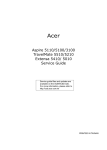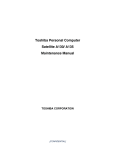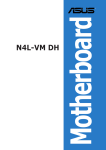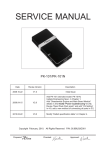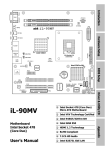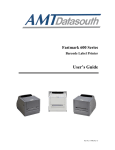Download Acer 510 Laptop User Manual
Transcript
Acer Aspire iDea 500/510 Series Service Guide Service guide files and updates are available on the ACER/CSD web. For more information, please refer to http:// csd.acer.com.tw PRINTED IN TAIWAN Revision History Please refer to the table below for the updates of Desktop Aspire iDea 500/510 service guide. Date October 30, 2006 II Chapter Updates first release Copyright Copyright© 2006 by Acer Incorporated. All rights reserved. No part of this publication may be reproduced, transmitted, transcribed, stored in a retrieval system, or translated into any language or computer language, in any form or by any means, electronic, mechanical, magnetic, optical, chemical, manual or otherwise, without the prior written permission of Acer Incorporated. III Disclaimer The information in this guide is subject to change without notice. Acer Incorporated makes no representations or warranties, either expressed or implied, with respect to the contents hereof and specifically disclaims any warranties of merchantability or fitness for any particular purpose. Any Acer Incorporated software described in this manual is sold or licensed “as is”. Should the programs prove defective following their purchase, the buyer (and not Acer Incorporated, its distributor, or its dealer) assumes the entire cost of all necessary servicing, repair, and any incidental or consequential damages resulting from any defect in the software. Acer is a registered trademark of Acer Incorporated. Other brand and product names are trademarks and/or registered trademarks of their respective holders. IV Conventions The following conventions are used in this manual: SCREEN MESSAGES Denotes actual messages that appear on screen. NOTE Gives bits and pieces of additional information related to the current topic. WARNING Alerts you to any damage that might result from doing or not doing specific actions. CAUTION Gives precautionary measures to avoid possible hardware or software problems. IMPORTANT Reminds you to do specific actions relevant to the accomplishment of procedures. V Preface Before using this information and the product it supports, please read the following general information. 1. This Service Guide provides you with all technical information relating to the BASIC CONFIGURATION decided for Acer's “global” product offering. To better fit local market requirements and enhance product competitiveness, your regional office MAY have decided to extend the functionality of a machine (e.g. add-on card, modem, or extra memory capability). These LOCALIZED FEATURES will NOT be covered in this generic service guide. In such cases, please contact your regional offices or the responsible personnel/channel to provide you with further technical details. 2. Please note WHEN ORDERING FRU PARTS, you should check the most up-to-date information available on your regional web or channel. For whatever reason, if a part number change is made, it will not be noted in the printed Service Guide. For ACER-AUTHORIZED SERVICE PROVIDERS, your Acer office may have a DIFFERENT part number code to those given in the FRU list of this printed Service Guide. You MUST use the list provided by your regional Acer office to order FRU parts for repair and service of customer machines. VI Table of Contents Chapter 1 System Specification 1 Specification . . . . . . . . . . . . . . . . . . . . . . . . . . . . . . . .1 Operating System . . . . . . . . . . . . . . . . . . . . . . . . . . . . . . Platform . . . . . . . . . . . . . . . . . . . . . . . . . . . . . . . . . . . . . . System Memory . . . . . . . . . . . . . . . . . . . . . . . . . . . . . . . Storage Subsystem . . . . . . . . . . . . . . . . . . . . . . . . . . . . . Audio . . . . . . . . . . . . . . . . . . . . . . . . . . . . . . . . . . . . . . . . Communication and Receiver . . . . . . . . . . . . . . . . . . . . . TV Tuner Subsystem . . . . . . . . . . . . . . . . . . . . . . . . . . . Display Subsystem . . . . . . . . . . . . . . . . . . . . . . . . . . . . . DV Camcorder Processing . . . . . . . . . . . . . . . . . . . . . . . Front Panel Indicators and Buttons . . . . . . . . . . . . . . . . . I/O Interface . . . . . . . . . . . . . . . . . . . . . . . . . . . . . . . . . . Power Subsystem . . . . . . . . . . . . . . . . . . . . . . . . . . . . . . Acoustic Estimation . . . . . . . . . . . . . . . . . . . . . . . . . . . . . Dimension and Weight . . . . . . . . . . . . . . . . . . . . . . . . . . 1 1 1 1 1 1 2 2 2 2 2 3 3 4 Block Diagram . . . . . . . . . . . . . . . . . . . . . . . . . . . . . . .5 Main Board Placement . . . . . . . . . . . . . . . . . . . . . . . .6 Front Panel View . . . . . . . . . . . . . . . . . . . . . . . . . . . . .9 Rear Panel View . . . . . . . . . . . . . . . . . . . . . . . . . . . .11 Remote Control . . . . . . . . . . . . . . . . . . . . . . . . . . . . .12 Using the Remote Control . . . . . . . . . . . . . . . . . . . . . . . 13 Wireless Keyboard . . . . . . . . . . . . . . . . . . . . . . . . . .14 Setting up the System . . . . . . . . . . . . . . . . . . . . . . . .16 Connecting the Power Cable . . . . . . . . . . . . . . . . . . . . Connecting Display Devices . . . . . . . . . . . . . . . . . . . . . Connecting to a TV Antenna or Cable . . . . . . . . . . . . . Connecting an FM Radio Antenna . . . . . . . . . . . . . . . . Connecting Audio Devices . . . . . . . . . . . . . . . . . . . . . . Configuring Audio Output Settings . . . . . . . . . . . . . . . . Setting up the Wireless Devices . . . . . . . . . . . . . . . . . . 16 17 20 20 21 22 22 Windows XP Media Center . . . . . . . . . . . . . . . . . . . .24 Opening Media Center . . . . . . . . . . . . . . . . . . . . . . . . . Media Center Home Page . . . . . . . . . . . . . . . . . . . . . . Configuring Your Set-Top Box . . . . . . . . . . . . . . . . . . . Closing Media Center . . . . . . . . . . . . . . . . . . . . . . . . . . 24 24 25 25 Acer eRecovery Management . . . . . . . . . . . . . . . . . .26 Launching Acer eRecovery Management . . . . . . . . . . . Copying the Factory Default Settings Image . . . . . . . . Creating System Backups . . . . . . . . . . . . . . . . . . . . . . . Creating an Incremental Backup . . . . . . . . . . . . . . . . . . TOC 26 26 26 27 VII Copying to Disks . . . . . . . . . . . . . . . . . . . . . . . . . . . . . . 27 Restoring the System . . . . . . . . . . . . . . . . . . . . . . . . . . 27 Other System Restore Modes . . . . . . . . . . . . . . . . . . . . 28 Acer ePerformance Management . . . . . . . . . . . . . . .30 Acer ePerformance Management Main Page . . . . . . . . 30 Hardware Specification and Configuration . . . . . . . .31 Power Management Function (ACPI Support Function) . . . . . . . . . . . . . . . . . . . . . . . . . . . . . . . . . . . . . . . . . .36 Device Standby Mode . . . . . . . . . . . . . . . . . . . . . . . . . . Global Standby Mode . . . . . . . . . . . . . . . . . . . . . . . . . . Suspend Mode . . . . . . . . . . . . . . . . . . . . . . . . . . . . . . . ACPI . . . . . . . . . . . . . . . . . . . . . . . . . . . . . . . . . . . . . . . 36 36 36 36 Chapter 2 Setup Utility 37 About the Setup Utility . . . . . . . . . . . . . . . . . . . . . . . .37 The Standard Configuration . . . . . . . . . . . . . . . . . . . . . 37 Entering the Setup Utility . . . . . . . . . . . . . . . . . . . . . . . 38 Product Information . . . . . . . . . . . . . . . . . . . . . . . . . .39 Standard CMOS Features . . . . . . . . . . . . . . . . . . . . .40 Advanced BIOS Features . . . . . . . . . . . . . . . . . . . . .41 Advanced Chipset Features . . . . . . . . . . . . . . . . . . .43 Integrated Peripherals . . . . . . . . . . . . . . . . . . . . . . . .44 Power Management Setup . . . . . . . . . . . . . . . . . . . .46 PnP/PCI Configuration . . . . . . . . . . . . . . . . . . . . . . .48 PC Health Status . . . . . . . . . . . . . . . . . . . . . . . . . . . .50 Frequency/Voltage Control . . . . . . . . . . . . . . . . . . . .51 Load Default Settings . . . . . . . . . . . . . . . . . . . . . . . .52 Set Supervisor/User Password . . . . . . . . . . . . . . . . .53 Save and Exit Setup . . . . . . . . . . . . . . . . . . . . . . . . . . . 54 Exit without Saving . . . . . . . . . . . . . . . . . . . . . . . . . . . . 54 Chapter 3 Machine Disassembly and Replacement 55 General Information . . . . . . . . . . . . . . . . . . . . . . . . .55 Before You Begin . . . . . . . . . . . . . . . . . . . . . . . . . . . . . 55 Disassembly Procedure . . . . . . . . . . . . . . . . . . . . . .56 Removing the Memory . . . . . . . . . . . . . . . . . . . . . . . . . Removing the Upper Case . . . . . . . . . . . . . . . . . . . . . . Removing the ODD Module . . . . . . . . . . . . . . . . . . . . . Removing the HDD Module . . . . . . . . . . . . . . . . . . . . . Removing the System Power Supply . . . . . . . . . . . . . . Removing the RCA Board . . . . . . . . . . . . . . . . . . . . . . . Removing the Add-on Cards . . . . . . . . . . . . . . . . . . . . . VIII 56 56 57 58 58 59 60 TOC Removing the MXM Card . . . . . . . . . . . . . . . . . . . . . . . 62 Removing the VFD Board . . . . . . . . . . . . . . . . . . . . . . . 63 Removing the Wireless Keyboard Module and the Bluetooth Module . . . . . . . . . . . . . . . . . . . . . . . . . . . . . . . . . . . . . . . . . . . . 64 Removing the CPU Fan . . . . . . . . . . . . . . . . . . . . . . . . 64 Removing the Card Reader Board . . . . . . . . . . . . . . . . 65 Removing the Main Board and the Split Board . . . . . . . 66 Chapter 4 Troubleshooting 67 Chapter 5 Jumper and Connector Information 68 Introduction of Connectors . . . . . . . . . . . . . . . . . . . .68 Upper Side of Main Board . . . . . . . . . . . . . . . . . . . . . . . 68 Lower Side of Main Board . . . . . . . . . . . . . . . . . . . . . . . 69 Jumper Setting and Power button . . . . . . . . . . . . . . . . . 70 Chapter 6 FRU (Field Replaceable Unit) List 71 Parts . . . . . . . . . . . . . . . . . . . . . . . . . . . . . . . . . . . . .72 TOC IX Chapter 1 System Specification Specification Operating System • Microsoft® Windows® XP Media Center Edition 2005 Rollup 2 (Emerald) Platform • Intel® Core Duo processor (Merom dual core) T5500/T5600/T7200/T7400/T7600 (2MB/4MB L2 cache, 1.66/1.83/2.0/2.16/2.83GHz, FSB 667MHz) • Intel® i945GT + ICH7M-DH chipset System Memory • 256, 512 or 1024MB of DDR2 533/667MHz memory • Dual channel • Upgradeable to 2GB using two soDIMM modules Storage Subsystem • 250/320/400/500GB 3.5” hard disk drive, SATA-II with NCQ • Slot-loading optical drive: DVD Dual or DVD Super Multi • Two card reader slots, XD/ SD/ MMC/ MS/ MS PRO/ MD/ CF-I/ CF-II/ MD support • Playback media support: CD, VCD, SVCD, CD-R/RW, DVD, DVD-DL, DVD-R, DVD-RW, DVD-R DL, DVD+R, DVD+RW, DVD+R DL (DVD-RAM support if with DVD Super Multi) • Recording media support: CD-R/RW, DVD-R, DVD-RW, DVD-R DL, DVD+R, DVD+RW, DVD+R DL (DVD-RAM support if with DVD Super Multi) Audio • Controller: Realtek ALC888DD • HD Audio, Dolby® Digital Live and DTS connect support • 7.1-CH analog output with S/PDIF support for digital output • Dolby® Digital surround 5.1-CH decoding and DTS digital output support • DTS Neo PC virtual surround to analog and digital output support • Audio digital to analog converter: 24bit/193KHz (10 DACs in total) • Audio playback file format support: CD-Audio (cda), Windows Media (asf/ asx/ wax/ wm/ wma/ wmd), Windows audio format (wav/ wmp/ wmx/ wvx) and MP3 (mp3/ m3u) Communication and Receiver • LAN controller: Intel® 82573L (Vidalia), GbE Ethernet; Wake-on-LAN ready • WLAN: 802.11b/g mini-PCI card with external antenna • WPAN: internal USB Bluetooth module • IR: internal beam-bag MCE compliant RC6 receiver with dual IR emitters Chapter 1 1 • Wireless keyboard: internal 2.4GHz RF wireless keyboard receiver with auto-pairing technology TV Tuner Subsystem • Support up to two hybrid mini-PCI TV tuner cards for simultaneous TV viewing and recording (2x Analog or 2x DVB-T • 3D Y-C comb filter support • World wide tuner all PAL/SECAM and NTSC TV format support • MPEG2 file format real time recording to HDD (200GB free space provides total 160 hours recording with fair quality setting: 71 hours recording with the best quality setting) support • Time shifting support • Up to three sets of S-A/V input selection support Display Subsystem • Add-on MXM card of nVidia GeForce Go 7600 (NB7P-GS, P478, G73M with HDMI version) • High definition display support • Component TV output (YPbPr): 480p/ 720p/ 1080i/ 1080p • Progressive VGA-output: 32bit/400MHz digital to analog converter, up to QXGA (2048 x 1536) • DVI output (with HDCP support): 640 x 480, 800 x 600, 1024 x 768, 1152 x 864, 1280 x 600, 1280 x 720, 1280 x 768, 1280 x 960, 1280 x 1024, 1440 x 900, 1440 x 1050, 1600 x 900, 1600 x 1200, 1680 x 1050, 1920 x 1080, 1920 x 1200 • HDMI output (with HDCP support): 480p/ 720p/ 1080i/ 1080p • Video playback file format support: Windows media (asf/ wmv), Windows video format (avi), movie file (mpeg/ mpg/ mpe/ m1v/ mpv2/ mpa) and Windows Metafile (wmf) • Picture playback file format support: jpeg/ jpg/ tif/ gif/ bmp/ wmf/ png DV Camcorder Processing • Transfer DV camcorder content into a DVD-Video disk (with direct mode and editing mode) support • Transfer DV camcorder content into MPEG2 video file(s) on HDD Front Panel Indicators and Buttons • Front panel VFD for MCE status and media title display • Media control keys: Stop, Play/Pause, Previous/REW, Next/FF and Rec • MCE Navigation buttons: Up, Down, Left, Right, OK, Back • Power button with power status LED • Normal working: blue • Away mode: amber-blinking • S3: amber • S4/S5: off I/O Interface Rear I/O • 2 Audio/Video output • One coaxial S/PDIF and 1 optical S/PDIF • One set of 7.1-channel (RCA) • One HDMI: HDCP support Chapter 1 • • • • One DVI-I: HDCP support, using DVI to VGA adapter for VGA output • One set of component (Y Pb Pr) (RCA) • One S-Video out • One Composite video out (RCA) Audio/Video input • Two S-Video in (non-EMEA SKU) • Two Composite in (RCA, non-EMEA SKU) • Two Stereo in (RCA, non-EMEA SKU) SCART ports (EMEA SKU only) • One SCART-in for S-Video, CVBS, Stereo input • One SCART-in/out for system’s CVBS, Stereo output and 2nd S-Video, CVBS, Stereo input (for dual TV tuner SKU) Other I/O ports • One RJ-45 GbE LAN port with LED indicators • One IEEE 1394a (6-pin) • Two USB 2.0 ports • Two IR blaster • One TV antenna/cable input • One TV antenna/cable output • One FM antenna input • One WLAN external antenna • One AC inlet • On MXM slot (optional) Front I/O • • • Audio/Video input/output • One 1/4-inch earphone output • One 1/4-inch microphone input • One S-Video in • One Composite in (RCA) • One Stereo in (RCA) Other I/O ports • One 4-pin IEEE 1394 • One CF socket for CF-I, CF-II and Micro Drive • One multi socket for SD/MMC/MS/MS PRO • Two USB 2.0 ports MB expansion slots • Two memory soDIMM sockets • Three mini-PCI slots Power Subsystem • FSP 120W AC internal power supply unit (FSP120-40GLS) Acoustic Estimation • 23 dBA (idle, 1M), 28 dBA (MCE heavy load, 1M) Chapter 1 3 Dimension and Weight 4 • 430 (W) x 335 (D) x 70 (H) mm with bezel, feet and WLAN antenna • Weight: 5.5 Kg Chapter 1 Block Diagram Chapter 1 5 Main Board Placement 6 Chapter 1 Chapter 1 7 No. 8 Description No. Description 1 CPU socket 2 North bridge 3 South bridge 4 Azalia codec: Realtek ALC883DD 5 Super I/O controller: ITE8716F 6 USB hub: GL850A 7 IEEE 1394: Ti TSB43AB22A 8 Transmitter for HDMI: Silicon Image 1390 9 Transmitter for DVI-I: Chrontel 7313A 10 Mini PCI 1 slot for TV tuner card 1 11 Mini PCI 2 slot for TV tuner card 2 12 Mini PCI 3 slot for WLAN card 13 YPbPr to main board connector 14 SCART to main board connector 15 Battery 16 MXM connector (optional) 17 System fan connector 18 SATA connector 19 14-pin power connector 20 Jumper connector 21 PATA connector 22 Card reader connector 23 Bluetooth connector 24 IR connector 25 CPU fan connector 26 VFD board connector 27 Power button connector 28 USB 2.0 ports 29 S-Video input jack 30 Video input jack 31 Audio input jack 32 1/4” microphone jack 33 1/4” headphone jack 34 RJ-45 port and two USB 2.0 ports 35 6-pin IEEE1394 port 36 USB 2.0 port 37 DVI-I connector 38 Video output jack and S-Video output jack 39 Multi-channel speaker audio output connectors 40 Coaxial digital audio output jack 41 BIOS chip: PMC PM49FL004T 42 Clock generator 43 soDIMM slot 44 soDIMM slot Chapter 1 Front Panel View No. Chapter 1 Component Description 1 Power button Press to power on or power off the system. 2 RF (radio frequency) receiver Receives radio frequency from wireless touchpad keyboard. 3 Drive eject button Ejects the optical disk. 4 Multi writable DVD drive Use to access and record data on compact disks (CDs) and digital video disks (DVDs) 5 IR (Infrared) receiver Receives IR signals from the remote control. 6 Playback controls Lets you conveniently play, record, pause, stop, forward, rewind, skip, or replay a song, slide show, movie or TV program. 7 VFD (Vacuum Fluorescent display) Displays the current Media Center status, current system date and time, or media title display. 8 MCE (Media Center Edition) navigation buttons • 8A: Press the Back button to return to the previous view. • 8B: Press the Left, Right, Up, or Down arrow buttons to navigate through the Media Center menu options. • 8C: Press the OK button to access the Media Center menu options and confirm your selection. 9 I/O ports cover release button Press to open the I/O ports cover. 9 No. Component Description 10 4-pin IEEE 1394 port Connects to an IEEE 1394 device (e.g., digital video camcorder). 11 XD/SD/MMC/MS/MS PRO slot Accepts an XD (eXtreme Digital), SD (Secure Digital), MMC (MultiMediaCard), MS (Memory Stick) or MS PRO (Memory Stick PRO) card. Warning!If you want to read contents from small form factor memory cards, such as mini-SD, RS-MMC, or MS PRO, you should use a suitable adaptor. 10 12 CF-I/CF-II/MD slot Accepts a CF (Compact Flash) Type I, CF Type II or Microdrive. 13 USB 2.0 ports Connects to USB peripherals devices (e.g., USB mouse, USB printer, USB combo drive, digital cameras). 14 S-Video input jack Connects to a video recorder, camcorder, or a device with S-Video output signal. 15 Video input jack Connects to a video recorder, camcorder, game console or a device with video output signal. 16 Audio input jack Connects t a video recorder, camcorder, audio casette player or stereo walkman. 17 1/4” microphone jack Connects to a microphone. 18 1/4” headphone Connects to a headphone. Chapter 1 Rear Panel View No. Chapter 1 Component Description 1 Power connector Plug the power cable into this connector. 2 SCART input connector Connects to a set-top box or another A/V device. The SCART input connector supports Video, SVideo and Audio (L and R) input signals. SCART input/output connector Connects to a TV or a set-top box. The SCART input/output connector supports Video, S-Video, Audio (L and R) input and Composite Video and Audio (L and R) output signals. 3 IR blaster ports Connects an IR blaster to the set-top-box’s IR sensor window. 4 LAN port Connects to an Ethernet 10/100/1000MB based network 5 TV antenna/cable output jack Connects to a television. 6 TV antenna/cable input jack Connects to an antenna or cable TV. 7 FM radio input jack Connects to an external FM radio antenna. 8 WLAN antenna connector Connects to a wireless LAN antenna. 9 Coaxial digital audio output jack 10 Optical digital audio output jack Connects to a digital device, such as MiniDisc recorders, home theater receivers, or A/V receivers. 11 Multi-channel speaker audio output connectors Connects to an amplifier which has multi-channel audio system. 12 Video output jack Connects to a TV with video output. 13 S-Video output jack Connects to a TV with S-Video input. 14 Component video output jack Connects to a TV with YPbPr input. 15 DVI-I connector Connects to a TV or LCD with DVI input or use the DVI-to-VGA adapter to connect a TV or monitor with VGA (D-Sub) input. 16 HDMI Connects to a TV with HDMI input. 17 6-pin IEEE 1394 port Connects to an IEEE 1394 device (e.g., digital video camcorder, hard disk, scanners). 18 USB 2.0 ports Connects to USB peripherals devices (e.g., USB mouse, USB printer, USB drive). 11 Remote Control No. 12 Component Description 1 Power LED Indicates that a command button is pressed. 2 Sleep Press to turn system to standby (sleep) mode. While in standby (sleep) mode, press the button again to wake up or activate the system. 3 Playback controls Lets you play, record, pause, stop, forward, rewind, skip or replay a song, slide show, movie or a TV program. 4 More Info Displays more information regarding the active TV program, video, album, or pictures. Chapter 1 No. Component Description 5 Navigation buttons The following navigation buttons let you access all Media Center pages: • Arrow buttons: navigates through the menu options. • OK: selects an option in the Media Center menus and confirm your selection. • Back: Moves back to the previous screen. 6 Start Press the Start button to launch the Media Center Home Page. 7 Channel/Page Moves pages up and down or changes the channels on the My TV page. 8 Mute Turns the system sound off and on. 9 DVD menu When a DVD video is playing, press this button to display the DVD disc’s main menu. 10 Live TV Displays a full screen view of a live TV program. 11 Numeric buttons Switches channels or inputs alphanumeric characters in the Media Center text box. 12 Teletext Turns Teletext on and off. 13 Enter Press to confirm your input or selection. 14 Teletext hotkeys When setting up programs in the TV menu, the following colored buttons have the following function: • Red: navigate to the previous page • Green: move to the next page • Yellow and blue: select, insert, and return to the Teletext menu. 15 Clear Press to erase the character you entered. 16 Guide Opens the TV Program Guide to display available channels and programs that you can watch and recorded. Note: Available in selected country and regions. 17 Recorded TV Displays the Recorded TV page. 18 Volume control Increases or decreases the volume. Note: The Teletext function is only available when the TV channel is broadcasting the Teletext programme. Teletext is a type of information service provided by the television broadcast companies. Teletext allows you to view the information of a video or program on your display device (i.e., news, weather, stock market, travel, etc.). Note: Remote control appearance (shape and buttons) may vary with region and retail configuration. Using the Remote Control The Media Center remote control complements the wireless keyboard. It includes control buttons that is commonly found on a DVD player, VCR or TV. Use the remote control to open the Media Center Edition program and navigate through menus and commands; to listen to music, watch TV and DVDs, and view pictures and slide shows. 1. Use the remote control to point towards the system’s IR receiver. Refer to “Front View” for the location of the IR receiver. 2. Press the Chapter 1 button to launch or return to the Media Centre Home Page. 13 Wireless Keyboard The wireless keyboard with built-in touch pad combines mouse control with touch typing. It has full-sized keys that include shortcut keys, status LED, power switch, touch pad, left and right buttons, arrow keys, one Windows key, left and right mouse keys, and 12 function keys. No. 14 Component Description 1 Shortcut keys Use the shortcut keys to do the following: • A Puts system to standby (sleep) mode. • B Launches Internet Explorer. • C Launches Microsoft Outlook Express. • D Launches Media player. • E Toggles the Media player sound on or off. • F Increases or decreases volume. • G Plays or pauses the Media player. 2 Status LED Displays the following functions: • Green LED indicates the keyboard is turned on. The LED will flash for three seconds to confirm it is powering on, then stops flashing. • Flashing Green LED indicates the keyboard is synchronized to the system. • Red LED indicates battery level is low. The LED will turn green then flash red for two seconds to indicate keyboard’s battery level is low. 3 Power switch Turns the keyboard on and off. Slide to the right to turn on the keyboard or slide to the left to power off the keyboard. 4 Touch pad Pointing device that senses movement on its surface. Move your finger on the surface of the touch pad to move the cursor. Chapter 1 No. 5 Component Description Left and right buttons Press the left and right buttons to select and execute functions. These two buttons are similar to the left and right buttons on a mouse. Tapping on the touch pad produces similar results to clicking the left button. 6 Arrow keys Moves the pointer around the Media Center menus. 7 Windows logo key Start button. Combinations with this key perform special functions, such as: • + Tab: Activate the next Taskbar button. • + E: Explore My Computer. • + F: Find Document. • + M: Minimize All. • Shift + • + M: Undo Minimize All. + R: Display Run dialog box. 8 Left and right mouse keys Press to simulate left and right mouse clicks. 9 Function keys (F1 to F12) The function keys lets you perform specific functions, depending on the application that uses them. Note: The keyboard may vary depending on region. Chapter 1 15 Setting up the System Connecting the Power Cable Note: Please use the corresponding power cord for your region. 16 Chapter 1 Connecting Display Devices Please refer to the illustrations below for the possible and recommended connection type for setting up your display device. Component (YPbPr) + stereo audio Video + stereo audio A B B A DVI + stereo audio* S-video + stereo audio Note: *Please use an extension cable to connect the Y cable to the display device’s speaker input. Chapter 1 17 SCART* HDMI C D DVI to VGA using converter + stereo audio A Note: Overscaling is a normal behavior on most TVs. We recommend using a TV that supports VGA or DVI connector, or enabling the dot-by-dot feature on your TV when connected with HDMI. 18 Chapter 1 The table below identifies the possible and recommended connection type for the display device. Display device type HD-ready devices: Plasma TV, LCD TV, Projection TV (with DVI or HDMI input) • • • • • • DVI HDMI VGA Component (YPbPr) S-Video Video HD-ready devices: Plasma TV, LCD TV, Projection TV (without DVI or HDMI input) • • • • VGA Component (YPbPr) S-Video Video Traditional SDTV Suggested connection Video + Audio Possible connection • SCART • S-Video • Video • DVI • Y cable1 • HDMI2 • DVI for video • Multi-channel analog or digital audio to A/V receiver • VGA • Y cable1 • Component • Stereo cable for audio • VGA for video • Multi-channel analog or digital audio to A/V receiver • Component (YPbPr) • Multi-channel analog or digital audio to A/V receiver • SCART • S-Video with stereo cable • Using S-Video’s stereo cable • A/V cable LCD or CRT monitor • DVI • VGA • DVI • Y cable1 • DVI • Multi-channel analog or digital audio to A/V receiver • VGA • Y cable1 Note: 1 Use an extension cable to connect the Y cable to the display device’s speaker input. 2 After connecting a device using HDMI, you can manually adjust the TV’s resolution to 720p or 1080p mode. To manually adjust your TV resolution mode, first exit Media Center (see “Closing Media Center”). Use the wireless touch pad to click on the 720p or 1080p icon on Windows desktop. To change to the display mode, click Yes to confirm. Finally, open the Media Center (see “Opening Media Center”). Chapter 1 19 Connecting to a TV Antenna or Cable A Connecting an FM Radio Antenna A Selecting an A/V Input Source After connecting a display device to the system, you can run Media Center to setup the display device’s input signal. 1. Open Media Center. See “Opening Media Center”. 2. Select My TV > More TV. 3. AV-input Source Selection will show on the right side of the screen, choose an input source from the following options: 20 • AV1/SCART1 - Video • AV1/SCART1 - S-Video • AV2 - Video • AV2 - S-Video • AV3/SCART2 - Video • AV3/SCART2 - S-Video Chapter 1 Connecting Audio Devices The following illustrations show the different audio devices you can connect to the Aspire iDea. Two Speakers Stereo front L + R B 5.1 Audio System and 7.1 Audio System 5.1 audio system 7.1 audio system B B Digital Digital Analog Analog Note: After you connect a 5.1 or 7.1 audio system, you must configure Media Center for multi-channel audio output. For more information, please refer to “To configure Media Center from multi-channel audio output:” on page 46 of user manual. The table below identifies the hardware and software configuration for setting up and adjusting CD- or DVD-audio playback. Sound track type Audio CD (with stereo sound track) Chapter 1 Hardware connection Audio output setting (DVD) Audio (stereo) Two speakers Digital S/PDIF Remark Configure the Realtek HD Audio in Media Center. Set up audio output for two speakers. 21 Hardware connection Sound track type DVD (with Dolby Digital AC-3 sound track) DVD (with DTS sound track) Audio output setting (DVD) Remark 7.1 or 5.1 channel audio Eight or six speakers Configure the Realtek HD Audio in Media Center. Set up audio output for eight or six speakers. Digital output S/PDIF To take advantage of Dolby Digital sound track, you need a Dolby Digital-equipped A/V receiver and speaker system with 5.1, 6.1 or 7.1 channels. 2 channel stereo analog output Two speakers Configure the Realtek HD Audio in Media Center. Set up audio output for two speakers. Digital out S/PDIF To take advantage of DTS sound track, you need a DTSequipped A/V receiver and speaker system with 5.1, 6.1 or 7.1 channels. Configuring Audio Output Settings After connecting Aspire iDea to your audio system, you can run Realtek HD Audio to set up and adjust the audio. 1. Open Media Center. 2. Select More Programs > Realtek HD Audio. 3. Select Speaker configuration. 4. For analog audio output, select the option describing the number of speakers connected to your system. For example, select 2 speakers if you have 2 speakers, 8 speakers if you have a 7.1 audio system and 6 speakers if you have a 5.1 audio system. 5. For digital audio output, the system default is to output audio source to both analog and digital. No special setting is needed. 6. To setup special surround sound effect, with the Realtek HD Audio, you can use the Dolby Digital Live or DTS connect to simulate 2-channel (stereo) sound into surround-sound effect. • Select Dolby and enable Dolby Digital Live. Dolby Digital Live encodes audio signals into a Dolby Digital 5.1 bitstream for multi-channel playback through surround sound system. • Select DTS and enable DTS Neo: PC or DTS interactive. DTS consists of DTS interactive and Neo: PC, for both multi-channel and stereo content. DTS interactive encodes audio signals into a DTS-compatible bitstream for multi-channel playback through a surround sound system. Neo: PC transforms stereo content, such as MP3, WMA, or CD audio, into 7.1-channel surround sound. 7. Press the OK button on the remote control or exit Media Center More Programs menu. Setting up the Wireless Devices Installing the Batteries in the Remote Control 1. Remove the battery cover from the rear side of remote control. 2. Insert two AA batteries into the battery compartment. 3. Then attach the battery cover to the remote control. Installing the Batteries in the Wireless Keyboard 1. Remove the battery cover from the bottom side of keyboard. 2. Insert two AA batteries into the battery compartment. 3. Then attach the battery cover to the keyboard. 22 Chapter 1 Installing the WLAN Antenna 1. Install antenna to the system by fastening the threaded end of the antenna into the WLAN antenna connector on the rear side of the system (1). 2. Rotate the antenna clockwise until it gets tight. 3. Flip up the antenna (2). Synchronizing the Keyboard On the bottom side of the keyboard, press and hold the Reset button until you see the green LED turns off. The keyboard’s LED flashes green to indicate the keyboard is ready synchronize to the system and stops flashing indicating a successful sync. Chapter 1 23 Windows XP Media Center Opening Media Center After turning on the system, system will launch Media Center. When working within a Windows XP program, you can revert to Media Center by doing any of the following: 1. Press on the remote control. 2. Press the Stop and Play/Pause buttons simultaneously on the front panel. 3. On the Windows task bar, click Start > All Programs > Accessories > Media Center, then click Media Center. 4. On the Windows task bar, click Start > Media Center. Media Center Home Page The Media Center Home Page displays whenever you open the Media Center. Use the navigation or shortcut buttons on the remote control or the arrow keys on the keyboard to select an option in the Start Menu. Item 24 Description Play DVD Plays your favorite DVDs. Online Spotlight Finds digital media content available for Media Center on the Internet, giving you access to the latest music, movies, trailers and news updates. My Videos Plays home videos or downloaded videos from the Internet. My Pictures Finds or sorts pictures stored in your system or view photos as a slide show. My TV Lets you watch or record live TV shows. Also allows you to pause and rewind up to 30 minutes of a live TV show. My Music Lets you browse, organize and play audio files or audio CDs. Radio Lets you listen to live radio programs. Also allows you to pause and rewind up to 30 minutes of live radio. More Programs Access the PSD, PnR, and other Media Center-enhanced programs available in your system. For more information, please refer to “Using accessory programs” of User’s Manual. Settings Access several settings that control how Media Center plays and records TV programs, plays DVDs, displays pictures, plays sound and displays Media Center pages. Chapter 1 Configuring Your Set-Top Box To configure Media Center to properly recognize a set-top box: 1. On the Media Center Home Page, select Setting. 2. Select TV > Set up TV signal in Media Center. 3. On the TV signal screen, select Next. 4. Select Yes to confirm region detected by Media Center. 5. Choose your TV signal, then select Next. 6. If you have a set-top-box, select Yes > Next, then proceed to step 7. If not select No > Next. 7. Select the number of tuners you want to configure, then select Next. 8. Select the type of cable connected to the set-top box, then select Next. 9. Set up your remote control to work with your set-top box, then select Next. 10. Choose your TV signal, then select Next. 11. Choose Yes if you have a set-top box remote control, then select Next. 12. Choose the number of digits for the highest channel number you receive on your system, then select Next. 13. Specify how you change channels, then select Next. 14. Select your set-top box brand, then select Next. 15. Choose a remote control code, then select Next. 16. Use the numeric buttons on the remote control to try changing channels, then select Next. 17. Select a remote control IR signal speed, then choose the number of digits you receive in you TV signal, then select Next. 18. Select Next to confirm signal speed. 19. After you finished setting up your TV signal, you will be prompted to set up your program guide. Closing Media Center 1. Press on the remote control to enter the Media Center Home Page. 2. Use the remote control to navigate to the Shut Down button on the upper left corner of the screen, then press OK. The Media Center shutdown window will appear and the optional items are Close Media Center, Log Off, Shut Down, Restart and Stand by. Warning!Never unplug the power cable when the system is in standby mode. Unplugging the power cable will cause irrecoverable errors to your system. 3. Select the desired item and press OK. Chapter 1 25 Acer eRecovery Management Warning!Always close the Media Center Edition before launching Acer eRecovery Management. Acer eRecovery Management provides fast, reliable and safe method of restoring your computer to its factory default settings or user-defined system configuration from an image stored in a hidden hard disk drive partition, secondary partition or optical disks. Acer eRecovery Management also features an easy-to-use utility that backs up system settings, applications and data to the hard disk drive to the optical disks. Launching Acer eRecovery Management You can launch Acer eRecovery Management in three ways: 1. Click Start > All Programs > Acer Empowering Technology > Acer eRecovery Management. 2. Press <Alt> + <F10> on the keyboard. 3. Click on the Acer eRecovery Management icon in the Empowering Technology tool bar on the desktop. Then Acer eRecovery Management main page will appear. Note: During initial launch, the Acer eRecovery Management prompts you to create a password for your backup files. Follow screen instructions to continue. Copying the Factory Default Settings Image 1. On initial launch, the utility prompts you to copy the factory default settings image saved in a hidden hard disk partition to an optical disk. 2. Insert the optical disk to the optical drive, then click OK to start burning. This function is disabled when the factory default setting image is copied, or when you check the Don’t remind me again option. Creating System Backups Creating a Full Backup You can create a full backup image of the current system configuration including all applications, drivers and data. Create a full backup before installing new hardware or software applications to protect your system and data. Warning!Creating a full backup erases the previous backup file in the hard disk drive. By default, the utility saves the backup image into the secondary hard disk drive partition. If there is insufficient space, the option is grayed out and a warning will appear. Backing up the image into the HDD ensures easy system recovery, without the need for optical disks. 1. Click the Backup button at the bottom of the window, then click Create. 26 Chapter 1 2. Select Full backup (slow), then click Next. 3. Enter a description of the backup image, then click Next. 4. When prompted, close all running applications, select Yes, then click Next. The backup process starts. A message will appear when the backup process is finished, or when it fails. Creating an Incremental Backup Instead of a full system backup, you can create an incremental backup image of the current system configuration to save space. Regular incremental backups are recommended to protect your system and data, especially before installing a new hardware component or software application. You can create multiple incremental backup points on top of one another. 1. Click the Backup button at the bottom of the window, then click Create. 2. Select Incremental backup (fast), then click Next. 3. Follow step 3 to step 4 of the previous section. Deleting a User-Created Backup Point You can delete a previously created backup image to free some HDD space. A confirmation message appears when you select this option. Click Yes to delete the backup image. 4. In the Acer eRecovery window, select Recovery actions and click Next. 5. Select the desired restore action and follow the instructions on screen to complete the restore process. Copying to Disks The Burn Disk function allows you to copy factory default settings images, backup images, current system configuration or application backups to a CD/DVD. Using the Burn Disk Utility 1. Click the Burn Disk button. 2. Select an option from the Burn Disk window. Burning a Backup Disk using Factory Default The utility creates a backup disk containing the factory default settings. Select this option if you disabled copying the factory default settings image when you first launch the Acer eRecovery Management. Burning a Backup Disk using User’s Backup The utility copies the user’s backup image to the optical disk. You can restore the system to the desired backup point using this disk. Copying Current System Configuration to Disk The utility copies the current system configuration to the optical disk. This option creates a temporary backup point with the current system configuration without replacing the previous full backup point. Burning an Application Backup Disk The utility backs up all applications and drivers to the optical disk. Restoring the System The Restore function allows you to restore the system configuration using the factory default settings images, backup images, current system configuration or application backups copied in the CDs/DVDs. Chapter 1 27 Restoring System to Factory Default Select to restore the computer to its original state. All previously installed programs and saved data will be lost. When selected, the computer reboots and restores the system from the image in the hidden hard disk drive partition. Restoring System from User’s Backup This allows you to restore the system using the most recent backup image you created. When selected, the backup image information will appear below the option. Recovering System from CD/DVD This allows you to restore the system using the backup image on the optical disk. When selected, the computer reboots from the optical drive. The utility prompts you to insert the backup disk, if not loaded in the optical drive. Reinstalling Applications/Drivers This allows you to reinstall a damaged application or device driver. Acer eRecovery Management extracts the data from the hidden hard disk drive partition. This process may take a few minutes and may disable the keyboard and mouse to ensure system stability. Other System Restore Modes You may also restore the system from the WinPE environment or through the hidden partition main page. Restoring the System from WinPE Environment If the system fails to boot, you can restore the system from WinPE environment. The system boots from the hidden hard disk drive partition to start recovery. Note: You are prompted to enter the password before system restore starts. Failure to enter the correct password three times reboots the computer to the operating system. Hidden Partition Main Page Press <Alt> + <F10> on the keyboard or the Stop and Record buttons on the front panel during POST to boot the system from the hidden hard disk drive partition and access the hidden partition main page. Note: You must enter the password to access the hidden partition main page. The hidden partition main page offers three options to restore the system: restore to factory default settings, restore from user’s backup, or restore from backup CD/DVD. Restoring System to Factory Default Settings 1. Select this option, then enter the password. The utility restores the system from the factory default settings image in the hidden hard disk drive partition. 2. When prompted, confirm system recovery. A message appears to tell you that you will lose all data on the drive. The utility then restores the system to its original state. Restoring System to User’s Backup 1. Select this option, then enter the password. The utility restores the system from the user’s backup image in the second hard drive partition. 2. When prompted, confirm system recovery. A message will appear to inform you that you will lose all data on the primary partition. The utility then restores the system to the most recent user backup. Restoring System from CD/DVD 1. Select this option, then enter the password. The utility restores the system from the user’s backup image in the second hard drive partition. 28 Chapter 1 2. When prompted, confirm system recovery. A message will appear to tell you that you will lose all data on the primary partition. The utility then restores the system to the most recent user backup. Restoring System from CD/DVD 1. When selected, insert the first backup disk to the optical drive. 2. Confirm system recovery when prompted. A message will appear to tell you that you will lose all data on the primary partition. The utility then restores the system from the backup image in the CD/DVD. 3. Insert the other disks when prompted. Note: If you are restoring the system to its factory default settings saved in CDs/DVDs, Acer eRecovery Management prompts you to insert disk 2 to start. Chapter 1 29 Acer ePerformance Management Note: Always close the Media Center Edition program before launching Acer ePerformance Management. Acer ePerformance Management offers you a simple-to-use tool to maximize your PC’s performance. Acer ePerformance Management enables you to optimize your PC’s memory, check memory usage to see if an upgrade is needed, optimize your HDD, and perform other functions to enhance the computer’s bootup, shutdown and network performance. You can launch Acer ePerformance Management in two ways: 1. On the Windows task bar, click Start > (All) Programs > Empowering Technology > Acer ePerformance Management. 2. Click on the Acer ePerformance Management icon n the Empowering Technology tool bar from your desktop which can be shown by pressing the Empowering Key. This will open the Acer ePerformance Management main page. Acer ePerformance Management Main Page The Acer ePerformance Management main page allows you to Execute Express Optimization to quickly optimize your system. Click Show at the bottom of the page to display the advanced optimization options: Memory, Disk and Speed. Memory Optimization Here, you can view your system’s current memory usage. You can also optimize the memory usage by clicking Optimize. Memory Usage Check When using your computer, you can check to see if a memory upgrade is advised by clicking Check. For the most accurate results, check memory usage when your computer is in a normal working setting - checking just after bootup, for example, will not yield an accurate report. Speed Optimization The five functions listed under Speed Optimization improve the overall performance of your computer. 1. Turbo Startup streamlines the startup process for faster booting. 2. Turbo Shutdown streamlines the shutdown process. 3. Performance Enhancement improves general performance. 4. Disk Defragmentation defragments the HDD while your computer is idle. 5. Network Booster improves network performance. 30 Chapter 1 Hardware Specification and Configuration Major Chips Item Specification System Core Logic • Intel 945GT • Intel ICH7M-DH Super I/O Controller ITE8716F LAN Controller Intel 82573L Memory Controller Intel 945GT IDE Controller Intel ICH7M-DH Audio Controller Realtek ALC883DD Graphics • Chip: Intel Gen 3.5 Integrated Graphic Engine • Transmitter for DVI-I (HDCP): Chrontel 7313A • Transmitter for HDMI: Silicon Image 1390 Card Reader controller ND3266 IEEE 1394 controller Ti TSB43AB22A USB 2.0 ICH7M-DH USB HUB GL850A System BIOS PMC PM49FL004T Clock generator ICS 580148 Processor Item Specification Type Intel Package 479 uFCPGA Core Speed / Host Bus Speed T ® T Yonah dual core processor 533 MT/s 667 MT/s BIOS Item Specification BIOS code programmer Award BIOS version R01-A1 BIOS ROM size 4MB BIOS ROM package 32-pin PLCC package Support protocol PCIX 1.0, PCI 2.2, APM 1.2, VESA/DPMS (VBE/PM V1.1), SMBIOS 2.3, E-IDE 1.1, ACPI 1.0b, ESCD 1.03, PnP 1.0a, Bootable CD-ROM 1.0, UHCI 1.0, ANSI ATA 3.0 ATAPI Boot from CD-ROM feature Yes LS-120 drive support Yes BIOS boot block feature Yes BIOS password control Yes Chapter 1 31 BIOS Hotkey Hotkey DEL Function Description Access to BIOS Setup Utility Press while the system is booting to enter BIOS Setup Utility. AC’97 Audio Codec ALC883DD Item Feature Description T T T T High performance DACs with 95Db S/N ratio Meets performance requirements for audio on PC2001 systems Eight channels of DAC support 16/20/24bit PCM format for 7.1 audio solution 48-pin LQFP package Wake-Up Event Specification S1 (Idle) S3 (Suspend to RAM) S4 (Suspend to Disk) S5 (Shut down) Power Button Enabled USB Keyboard Enabled Enabled Enabled Enabled Enabled Disabled Enabled WOL (wake on LAN) Disabled Disabled Disabled Disabled RTC (real time clock) Disabled N/A Disabled Disabled Devices System Memory Item Feature Specification T T T T T T T T Dual channel support Maximum memory size Two GB Two soDIMM sockets 256/512MB or One GB support per slot Memory voltage support: 1.8V 533/667MHz unbuffered module Error correction code (ECC) feature: yes Memory module combinations: You can install memory modules in any combination as long as they match the above specification. LAN Interface Item Feature Specification T T T T 32 Intel 82573L (Vidalia) PCI-E x1 GbE LAN controller Controller resident bus: PCI bus One RJ-45 on board Enabled or Disabled by BIOS setup Chapter 1 IDE Interface Item Specification Controller Intel ICH7M-DH with PATA and SATA controller 40-pin PATA slot T T T T SATA IDE slot T T Quantity: one Device type support: HDD / CD-ROM / CD-RW / DVDROM / Combo, DVD burner Transfer rate support: PIO 0/1/2/3/4 ATA mode: 33/66/100 Quantity: one Max. data rate will be 3.0 Gb/sec. LS-120 support Yes Bootable CD-ROM support Yes Function control Enabled or Disabled by BIOS setup Chapter 1 33 ODD Interface Item Specification Vendor and Model name Panasonic UJ-845 Performance Specification Transfer rate (MB/s.) READ WRITE DVD-ROM (single layer) 3.3X to 8X CAV 4.3 MB/s. to 10.5 MB/s. - DVD-ROM (dual layer) 2.5X to 6X CAV 3.3 MB/s. to 7.9 MB/s. - DVD-R 4.7GB 2.5X to 6X CAV 3.3 MB/s. to 7.9 MB/s. 2X to 8X Z-CLV 2.6 MB/s. to 10.5 MB/s. DVD-R 3.95GB 2.5X to 6X CAV 3.3 MB/s. to 7.9 MB/s. - DVD-RW 4.7GB 2.5X to 6X CAV 3.3 MB/s. to 7.9 MB/s. 2X to 4X Z-CLV 2.6 MB/s. to 5.3 MB/s. DVD-RAM 4.7GB 3X to 5X Z-CLV 3.9 MB/s. to 6.5 MB/s. 3X to 5X Z-CLV 3.9 MB/s. to 6.5 MB/s. +R (single layer) 2.5X to 6X CAV 3.3 MB/s. to 7.9 MB/s. 2.4X to 8X Z-CLV 3.2 MB/s. to 10.5 MB/s. +R (dual layer) 2.5X to 6X CAV 3.3 MB/s. to 7.9 MB/s. 2.4X CLV 3.2 MB/s. +RW 2.5X to 6X CAV 3.3 MB/s. to 7.9 MB/s. 2.4X to 4X Z-CLV 3.2 MB/s. to 5.3 MB/s. CD-ROM 10.3X to 24X CAV 1550 KB/s. to 3600 KB/s. - CD-R 10.3X to 24X CAV 1550 KB/s. to 3600 KB/s. 8X to 24X Z-CLV 1200 KB/s. to 3600 KB/s. CD-RW 10.3X to 24X CAV 1550 KB/s. to 3600 KB/s. 10X CLV 1500 KB/s. DVD-Video 4X CAV - CD-DA (Audio Play) 12X CAV - CD-DA (Read) 20X CAV - Video-CD 20X CAV - READ WRITE • CD-Audio, CD-ROM, CDROM XA, CD-I, CD-I Ready, Cd-I Bridge, CDR, CD-RW, Photo CD, Video CD, Enhanced Music CD, CD-TEXT • DVD-5, DVD-9, DVD-10, DVD-18, DVD-R (3.95GB/4.7GB), DVDRW, DVD-RAM (4.7GB), +R, +RW • DVD-RAM, DVD-R 4.7GB, DVD-RW, +R, +RW • CD-R, CD-RW Applicable disc format 34 Chapter 1 USB Interface Item Specification Controller Intel ICH7M-DH Universal HCI USB 2.0 Location and quantity From ICH7M-DH: • Two-port stack USB connector on rear side • Two-port stack USB port connector on front panel • One USB port for Card reader (ND3266) • One USB port for RF connector • One USB port for bluetooth connector • One USB port for USB hub (GL850A) From USB hub GL850A • One USB port for VFD display (WT6563F) • One USB port for IR control • One USB port for button control Environment Requirements Item Specification Temperature Operating +10oC ~ +35oC Non-operating -20oC ~ +60oC (storage packed), -10oC ~ +60oC (unpacked) Humidity Operating 20% to 80% RH, non-condensing Non-operating 20% to 80% RH, non-condensing (unpacked) 20% to 80% RH, non-condensing (Storage package) Vibration Operating 5 ~ 500Hz, 2.20g RMS random, 10 minutes per axis in all three axes Non-operating 5 ~ 500Hz, 1.09g RMS random, one hour per axis in all three axes Drop Test Package Gross Weight (KG/lbs) Drop Height (cm/inch) No. of Drop 0 ~ 9.1 (0 ~ 20) 76/30 10 9.1 ~ 18.2 (20 ~ 40) 61/24 10 18.2 ~ 27.3 (40 ~ 60) 46/18 10 27.3 ~ 45.4 (60 ~ 100) 31/12 10 10 drops: one corner, three edges, six surfaces Note: The protection ability of package and cushion must be capable of withstanding, with no physical or functional damage, mechanical impact from height-specified drops. Chapter 1 35 Power Management Function (ACPI Support Function) Device Standby Mode • Independent power management timer for hard disk drive devices (zero to 15 minutes, time step = one minute). • Hard disk drive goes into Standby mode (for ATA standard interface). • Disable V-sync to control the VESA DPMS monitor. • Resume method: device activated (keyboard for DOS, keyboard & mouse for Windows). • Resume recovery time: three to five seconds. Global Standby Mode • Global power management timer (two to 120 minutes, time step = 10 minutes). • Hard disk drive goes into Standby mode (for ATA standard interface). • Disable H-sync and V-sync signals to control the VESA DPMS monitor. • Resume method: return to original state by pushing external switch button, modem ring in, keyboard and mouse for APM mode. • Resume recovery time: seven to 10 seconds. Suspend Mode • Independent power management timer (two to 120 minutes, time step = 10 minutes) or pushing external switch button. • CPU goes into SMM. • CPU asserts STPCLK# and goes into the Stop Grant state. • LED on the panel turns amber colour. • Hard disk drive goes into SLEEP mode (for ATA standard interface). • Disable H-sync and V-sync signals to control the VESA DPMS monitor. • Ultra I/O and VGA chip go into power saving mode. • Resume method: return to original state by pushing external switch button, modem ring in, keyboard and mouse for APM mode. • Return to original state by pushing external switch button, modem ring in and USB keyboard for ACPI mode. ACPI 36 • ACPI specification 1.0b • S0, S1, S3 and S5 sleep state support • Onboard device power management support • Onboard device configuration support Chapter 1 Chapter 2 Setup Utility About the Setup Utility The computer uses the Phoenix-Award BIOS (Basic Input and Output System) with support for Windows Plug and Play. The CMOS chip on the main board contains the ROM setup instructions for configuring the main board BIOS. The BIOS Setup Utility displays the system’s configuration status and provides you with options to set system parameters. The parameters are stored in Battery-backed-up CMOS RAM that saves this information when the power is turned off. When the system is turned back on, the system is configured with the values you have stored in CMOS. The settings made in the Setup Utility affect how the computer performs. Before using the Setup Utility, ensure that you understand the Setup Utility options. The Standard Configuration A standard configuration has already been set in the Setup Utility. However, it is recommended that you read this chapter in case you need to make any changes in the future. This Setup Utility should be used: • when changing the system configuration • when a configuration error is detected and you are prompted to make changes to the Setup Utility • when trying to resolve IRQ conflicts • when making changes to the Power Management configuration • when changing the password or making other changes to the Security Setup Chapter 2 37 Entering the Setup Utility When you power on the system, BIOS enters the Power-On Self Test (POST) routines. POST is a series of built-in diagnostics performed by the BIOS. After the POST routines are completed, the following message will appear: Press DEL to enter SETUP Press the delete key to enter the BIOS Setup Utility. BIOS Navigation Keys The BIOS navigation keys are listed below. Key ESC IKLJ 38 Function Exits the current menu Scrolls through the items on a menu +/-/PU/PD Modifies the selected field’s values F10 Saves the current configuration and exits setup F1 Displays a screen that describes all key functions F5 Loads previously saved values to CMOS F6 Loads a minimum configuration for troubleshooting F7 Loads an optimum set of values for peak performance Chapter 2 Product Information This option displays product information about your system. You can press <Esc> to return to the main menu setting page. Chapter 2 39 Standard CMOS Features This option displays basic information about the system. Date and Time The Date and Time items show the current date and time set on the computer. If you are running a Windows OS, these items are automatically updated whenever you make changes to the Windows Date and Time Properties utility. IDE Devices Your computer has one IDE channel and one SATA connector supporting one SATA drive. SATA refers to Serial ATA (Advanced Technology Attachment), the standard interface for the IDE hard drives which are currently used in most PCs. 40 Chapter 2 Advanced BIOS Features This option defines advanced information about your system. Hard Disk Boot Priority Scroll to this item and press <Enter> to view the following screen. First / Second / Third Boot Device Use this three items to select the priority and order of the devices that your system searches for an operating system at start-up time. Boot Up NumLock Status This item defines if the keyboard NumLock key is active when your system is booted. Typematic Rate Setting If this item is enabled, you can use the following two items to set the typematic rate and the typematic delay settings for your keyboard. • Typematic Rate (Char/Sec): Use this item to define how many characters per second are generated by a held-down key. • Typematic Delay (Msec): Use this item to define how many milliseconds must elapse before a held-down key begins generating repeat characters. Chapter 2 41 Security Option If you have installed password protection, this item defines if the password is required at system start up, or if it is only required when a user tries to enter the Setup Utility. Silent Boot This item enables or disables the Silent Boot function. Small Logo (EPA) Show This item enables or disables the display of the EPA logo during boot. Configuration Table This item enables or disables the Configuration Table in BIOS setting. 42 Chapter 2 Advanced Chipset Features These items define critical timing parameters of the main board. You should set these items for their default values unless you are very familiar with the technical specification of your system hardware. If you change the values incorrectly, you may introduce fatal errors or recurring instability into your system. PEG / OnChip VGA Control This item allows you to choose the primary display card. Onchip Frame Buffer Size This allows you to set the VGA frame buffer size. DVMT Mode DVMT is Dynamic Video Memory Technology. This item helps you select video mode. Chapter 2 43 Integrated Peripherals These options display items that define the operation of peripheral components on the system’s input/output ports. USB Controller You can enable or disable the onboard USB controller. We recommend users to keep the default value. Disabling it might cause the USB devices not to work properly. USB 2.0 Controller This item enables or disables the onboard USB 2.0. USB Keyboard Support You can enable this item if you want to use a keyboard connected through the USB port in a legacy operating system (such as DOS) that does not support Plug and Play. Azalia/AC97 Audio Select It serves to enable or disable the onboard Azalia/AC97 audio function. You can disable this item if you are going to install a PCI audio add-on card. Onboard LAN Boot ROM This item allows you to enable or disable the onboard LAN Boot ROM function. 44 Chapter 2 Onboard LAN Controller This item allows users to enable or disable the onboard LAN Controller function. Onboard 1394 Controller This item allows users to enable or disable the onboard 1394 Controller function. Chapter 2 45 Power Management Setup The system has various power-saving modes including powering down the hard disk, turning off the video, suspending to RAM, and software power down that allows the system to be automatically resumed by certain events. The power-saving modes can be controlled by time-outs. If the system is inactive for a while, the time-outs begin counting. If the inactivity continues so that the time-out period elapses, the system enters a power-saving mode. If any item in the list of Reload Global Timer Events is Enabled, then any activity on that item will reset the time-out counters to zero. If the system is suspended or has been powered down by software, it can be resumed by a wake up call that is generated by incoming traffic to a modern, a LAN card, a PCI card, or a fixed alarm on the system real-time clock. ACPI Function This item allows users to enable or disable the ACPI power management function. ACPI Suspend Type You can use this item to define how your system suspends. In the default, S3 (STR), the suspend mode is a suspend to RAM, i.e., the system shuts down with the exception of a refresh current to the system memory. Soft-Off by PWR-BTTN Under ACPI (Advanced Configuration and Power Management Interface) you can create a software power down. In a software power down, the system can be resumed by Wake Up Alarms. This item lets you install a software power down that is controlled by the power button on your system. If the item is set for Instant-Off, then the power 46 Chapter 2 button causes a software power down. If the item is set for Delay four Sec., then you have to hold the power button down for four seconds to cause a software power down. Energy Lake Function This item enables or disables the Energy Lake Function. Resume by PCI PME This item specifies whether the system will be awakened from power-saving modes when activity or input signal of the specified hardware peripheral or component is detected. Wake Up On LAN When it is set for Enabled, you can remotely wake up a PC in Soft-Off condition via a LAN card that supports the wake up function. Resume by Alarm When it is set for Enabled, additional fields become available and you can set the date, hour, minute and second to turn on your system. When it is set for zero in the column of date, the alarm will power on your system every day at the specified time. Power On After Power Fail This item enables your computer to automatically restart or return to its last operating status after power returns from power failure. Chapter 2 47 PnP/PCI Configuration It configures how PnP (Plug and Play) and PCI expansion cards operate in your system. Both the ISA and PCI buses on the main board use system IRQs (interrupt requests) and DMAs (direct memory access). You must set up the IRQ and DMA assignments correctly through the PnP/PCI Configurations Setup Utility for the main board to work properly. Selecting PnP/PCI Configurations on the main program screen displays the menu below. Reset Configuration Date If you enable this item and restart the system, any Plug and Play configuration data stored in the BIOS Setup will be cleared from memory. Resources Controlled By Auto You should set this item for the default Auto (ESCD). Under this setting, the system dynamically allocates resources to Plug and Play devices as they are required. If you can not get a legacy ISA expansion card to work properly, you might be able to solve the problem by changing this item to Manual, and then opening up the IRQ Resources submenu. • 48 IRQ Resource: In the IRQ Resource submenu, if you assign an IRQ to Legacy ISA, the Interrupt Request Line is reserved for a legacy ISA expansion card. Press <Esc> to close the IRQ Resource submenu. In the Memory Resources submenu, use the first item Reserved Memory Base to set the start address of the memory you want to reserve for the ISA expansion card. Use the section item Reserve Memory Length to set the amount of reserved memory. Press <Esc> to close the Memory Resources submenu. Chapter 2 PCI/VGA Palette Snoop This item is designed to overcome problems that can be caused by some non-standard VGA cards. This board includes a built-in VGA system that does not require palette snooping so you must leave this item disabled. INT Pin 1-8 Assignment It identifies the interrupt request (IRQ) line assigned to a device connected to the PCI interface of your system. Maximum Payload Size This item specifies the maximum TLP payload size for the PCE Express devices. The unit is byte. Chapter 2 49 PC Health Status On the main board that supports hardware monitoring, you can monitor the parameters of critical voltage, temperature and fan speed. CPU and System Smart Fan Control This item incorporates linear control metrics to provide optimal cooling. Under normal condition, Smart Fan keeps the fan speed low, minimizing acoustic noise. When the load increases, Smart Fan increases the fan speed to provide optimal cooling. Shutdown Temperature You can set the maximum temperature of the system. When the system reaches that temperature, it will be powered down. 50 Chapter 2 Frequency/Voltage Control It enables you to set the clock speed and system bus for your system. The clock speed and system bus are determined by the processor you have installed in your system. CPU Speed This item displays the current CPU speed. Users can not make any changes. Auto Detect PCI Clk When it is enabled, BIOS will disable the clock signal of free DIMM and PCI slots. Spread Spectrum If you enable spread spectrum, it can significantly reduce the EMI (Electro-Magnetic Interference) generated by the system. Chapter 2 51 Load Default Settings This option opens a dialog box that lets you install optimized defaults for all appropriate items in the Setup Utility. Press <OK> and then <Enter> to install the defaults. Press <Cancel> and then <Enter> to not install the defaults. If you only want to install setup defaults for a specific option, select and display that option, and then press <F9>. 52 Chapter 2 Set Supervisor/User Password When this function is selected, the following message appears at the center of the screen to assist you in creating a password. Enter Password Type the password, up to eight characters, and press <Enter>. The password typed now will clear any previously entered password from CMOS memory. You will be asked to confirm the password. Type the password again and press <Enter>. You can press <Esc> to abort the selection. To disable password, just press <Enter> when you are prompted to enter password. A message will confirm the password being disabled. Once the password is disabled, the system will boot and you can enter BIOS Setup freely. Password Disabled If you have selected “System” in “Security Option” of “BIOS Features Setup” menu, you will be prompted for the password every time the system reboots or any time you try to enter BIOS Setup. If you have selected “Setup” at “Security Option” of “BIOS Features Setup” menu, you will be prompted for the password only when you enter BIOS Setup. Supervisor Password has higher priority than User Password. You can use Supervisor Password when booting the system or entering BIOS Setup to modify all settings. Also you can use User Password when booting the system or entering BIOS Setup but can not modify any setting if Supervisor Password is enabled. Chapter 2 53 Save and Exit Setup You can highlight this item and press <Enter> to save the changes that you have made in the Setup Utility and exit the Setup Utility. When the Save and Exit dialog box appears, press <OK> to save and exit, or press <Cancel> to return to the main menu. Exit without Saving You can highlight this item and press <Enter> to discard any changes that you have made in the Setup Utility and exit the Setup Utility. When the Exit without Saving dialog box appears, press <OK> to discard changes and exit, or press <Cancel> to return to the main menu. Note: If you have made settings that you do not want to save, choose the “Discard Changes and Exit” and press <OK> to discard any changes you have made. 54 Chapter 2 Chapter 3 Machine Disassembly and Replacement General Information This chapter contains step-by-step procedures on how to disassemble the Acer Aspire iDea desktop for maintenance and troubleshooting. To disassemble the computer, you need the tools below: • Wrist ground strap and conductive mat for preventing electrostatic discharge • Small Philips screw driver • Plastic flat head screw driver Note: The screws for the different components vary in size. During the disassembly process, group the screws with the corresponding components to avoid mismatch when putting back the components. When you remove the stripe cover, please be careful not to scrape the cover. Before You Begin Before proceeding with the disassembly procedure, you have to make sure that: 1. The system and all peripherals are powered off. 2. The AC adaptor and all power and signal cables from the system are unplugged. Note: There are several types of screws used to secure the main unit. The screws vary in length. Group the same type of screws together during the disassembly procedure. Please also remember the screw location for each screw type. If you fasten the screws on the wrong location, the long screws may cause irrecoverable damage to the parts. Chapter 3 55 Disassembly Procedure This section tells you how to disassemble the system when you need to perform system maintenance or troubleshooting. Note: Before you begin, make sure you have turned off the system and remove all peripherals connected to it. Removing the Memory 1. Release the screw holding the memory module cover on the bottom side. 2. Pull the latches as the arrows indicate and the memory will pop-up. Then remove the memory. 3. You can skip this step because the removal of memory is not a necessary step for disassembly of other parts. Removing the Upper Case 1. Release the three screws securing the upper case and pull the upper case as the arrows indicate to remove it. 56 Chapter 3 Removing the ODD Module 1. Pull and disconnect the IDE cable. 2. Release the three screws holding the ODD module bracket then remove the ODD module. 3. Release the two screws holding the IDE board then remove the IDE board. 4. Release the three screws securing the ODD module bracket then remove the bracket. Chapter 3 57 Removing the HDD Module 1. Release the four screws securing the HDD module and detach the HDD module. 2. Disconnect the serial ATA cable and the power cable and remove the HDD module. 3. Release the four screws securing the HDD module brackets and remove the brackets. Removing the System Power Supply 1. Pull and disconnect the power cable and the fan cable. 2. Release the four screws securing the system power supply and remove the system power supply. 58 Chapter 3 Removing the RCA Board 1. When you do the assembly, please refer to this picture for connecting the three RCA board cables properly. 2. Carefully disconnect the three RCA board cables. 3. Release the three screws holding the RCA board and detach the RCA board. 4. Release the two screws on the RCA board and remove the RCA board bracket. Chapter 3 59 Removing the Add-on Cards 1. When you do the assembly, please refer to this picture for connecting the add-on cards cables properly. 60 Chapter 3 2. Pull the latches of TV card 1 as shown and the card will pop up. Slightly detach the TV card 1 from the slot and disconnect the card cable. 3. Repeat the step 2 to detach the TV card 2 and disconnect the card cable. 4. Repeat the step 2 to detach the wireless LAN card and disconnect the card cable. Chapter 3 61 Removing the MXM Card 1. Disconnec the MXM card fan cable and the MXM card heat sensor cable. 2. Release the four screws holding the MXM card fan module then remove the MXM card fan module. 3. Release the two screws fastening the MXM card and the MXM card will pop up. 4. Then pull out the MXM card at 45o degree as the arrow indicates. 62 Chapter 3 Removing the VFD Board 1. On the main board, there are five connectors as shown. They are A) power launch cable connector, B) VFD board cable connector, C) CPU fan cable connector, D) wireless keyboard module cable connector and E) bluetooth module cable connector. 2. To remove the front panel, at least you have to disconnect B) VFD board cable and release the screw securing the VFD board cable. 3. Unlatch the five latches holding the front panel as shown. Then carefully detach the front panel from the main unit and pull out the VFD board cable at the same time. 4. Disconnect the VFD board cable. 5. Release the four screws and you have access to the VFD board. Chapter 3 63 Removing the Wireless Keyboard Module and the Bluetooth Module 1. As long as remove the front panel, you can approach the wireless keyboard module and the bluetooth module. Please refer to the anterior page for the removal of front panel. 2. Disconnect D) wireless keyboard module cable and E) bluetooth module cable. 3. Release the four screws securing the wireless keyboard module and the bluetooth module and carefully remove the wireless keyboard module and the bluetooth module. You can abort the disassembly procedures at this step if you are not going to remove the main board. 4. If you want to remove the main board next, please remove the bracket at this step. After the completion of step 3, please release the two screws holding the bracket and remove the bracket. Removing the CPU Fan 1. Disconnect C) CPU fan cable. 2. Release the four screws fastening the CPU fan and remove the CPU fan. 64 Chapter 3 Removing the Card Reader Board 1. Release the screw securing the card reader as shown. 2. Carefully detach the card reader from the main board. 3. When you do the assembly, please attach the card reader board on the main board properly. Chapter 3 65 Removing the Main Board and the Split Board 1. Release those screws marked in yellow. 2. While you release those screws, please hold the back side of the I/O jacks as shown. 3. After releasing those screws, 1) slide the main board to the front panel side and 2) lift the main board as shown. Then detach the main board from the lower case. 4. Detach the split board from the main board as shown. 66 Chapter 3 Chapter 4 Troubleshooting Please refer to generic troubleshooting guide in the service guide database for information with respect to following topics: • Power-On Self-Test (POST) • POST Check Points • POST Error Messages List • Error Symptoms List Chapter 4 67 Chapter 5 Jumper and Connector Information Introduction of Connectors Upper Side of Main Board Chapter 5 68 Lower Side of Main Board No. 69 Description No. Description 1 CPU socket 2 North bridge 3 South bridge 4 Azalia codec: Realtek ALC883DD 5 Super I/O controller: ITE8716F 6 USB hub: GL850A 7 IEEE 1394: Ti TSB43AB22A 8 Transmitter for HDMI: Silicon Image 1390 9 Transmitter for DVI-I: Chrontel 7313A 10 Mini PCI 1 slot for TV tuner card 1 Chapter 5 No. Description No. Description 11 Mini PCI 2 slot for TV tuner card 2 12 Mini PCI 3 slot for WLAN card 13 YPbPr to main board connector 14 SCART to main board connector 15 Battery 16 MXM connector (optional) 17 System fan connector 18 SATA connector 19 14-pin power connector 20 Jumper connector 21 PATA connector 22 Card reader connector 23 Bluetooth connector 24 IR connector 25 CPU fan connector 26 VFD board connector 27 Power button connector 28 USB 2.0 ports 29 S-Video input jack 30 Video input jack 31 Audio input jack 32 1/4” microphone jack 33 1/4” headphone jack 34 RJ-45 port and two USB 2.0 ports 35 6-pin IEEE1394 port 36 USB 2.0 port 37 DVI-I connector 38 Video output jack and S-Video output jack 39 Multi-channel speaker audio output connectors 40 Coaxial digital audio output jack 41 BIOS chip: PMC PM49FL004T 42 Clock generator 43 soDIMM slot 44 soDIMM slot Jumper Setting and Power button No. 20 27 Item Description Jumper 1-2 NORMAL (default) 2-3 CLR CMOS Power button 5 4 3 2 1 1-2 power button 3-5 power LED Chapter 5 70 Chapter 6 FRU (Field Replaceable Unit) List This chapter offers the FRU (Field Replaceable Unit) list in global configuration of Aspire iDea 500/510 desktop. Refer to this chapter whenever ordering the parts to repair or for RMA (Return Merchandise Authorization). Please note that when ordering FRU parts, you should check the most up-to-date information available on your regional web or channel. For whatever reasons a part number is changed, it will NOT be noted on the printed service guide. For Acer authorized service providers, your Acer office may have a different part number code from those given in the FRU list of this printed service guide. You MUST use the local FRU list provided by your regional Acer office to order FRU parts for service. Note: To scrap or to return the defective parts, you should follow the local government ordinance or regulations on how to dispose them properly, or follow the rules set by your regional Acer office on how to return it. Chapter 6 71 Parts CATEGORY PART NAME DESCRIPTION ACER PART NO. REMOTE CONTROL N/A REMOTE CONTROLER RC1534509/00B PAL FOR EUROPE REMOTE CTRL RC1534509/00B PAL RT.MCE08.001 N/A REMOTE CONTROLER RC1534031/00B NTSC FOR TWN REMOTE CTRL RC1534031/00B NTSC RT.MCE08.003 WIRELESS LAN BOARD 802.11BG FOXCONN BCM4318 WLAN 802.11BG FOX BCM4318 MURA 54.A74V1.002 TV TUNER BOARD TV TUNER MINIPCI MPC-718 (353) TU.S5000.001 CARD READER BOARD P600X/HAVC5.0 CARD READER BD 55.S50V1.003 SPLITTER BOARD PAL P600X/HAVC5.0 SPLITTER PAL BD 55.S50V1.004 IDE BOARD P600X/HAVC5.0 IDE BD 55.S50V1.005 RF RECEIVER BOARD 2.4G RF RECEIVER BD 832015-0001 2.4 RV.RAN01.001 SCART BOARD P600X/HAVC5.0 SCART BD 55.S50V1.002 VGA BOARD NVIDIA M760GO VGA CARD NVIDIA M760GO 55.S6201.001 CONNECTOR 24+5ML/15FML CONN 24+5ML/15FML PI12.A22C32 20.S50V1.001 BOARD N/A N/A CABLE N/A 72 Chapter 6 CATEGORY PART NAME DESCRIPTION ACER PART NO. N/A POWER CORD SVT 10A125V USA CORD SVT 18AWG*3C 10A125V(USA) 27.01818.071 N/A POWER CORD 10A 250V EUROPE CORD H05VV-F 10A/ 250V(EUROPE) 27.02718.401 N/A POWER CORD 13A 250V UK CORD H05VV-F 5A250V (UK) 27.02718.381 N/A POWER CORD 250V 10A 1800MM SWISS CORD 250V 10A 1800MM SWISS 27.01518.251 N/A POWER CORD 250V 10A 1800MM DENMARK CORD 250V 10A 1800MM DENMARK 27.01518.201 N/A HDD CABLE SATA 200MM C.A.SATA 200MM HD304 50.S6201.001 N/A FRONT BEZEL ASSY FRONT BEZEL OSCAR PLUS 60.S6201.001 OPTICAL CABLE C.A. ODD HD304 50.S50V1.003 VFD-A CABLE C.A. VFD-A HD304 50.S6201.002 TV-S CABLE 8PIN C.A. TV-S 8PIN HD304 50.S50V1.005 TV-S IR CABLE 10PIN C.A. TV-S IR 10PIN CABLE 50.S50V1.006 SCART CABLE OUT C.A. SCART OUT HD304 50.S50V1.007 SPLITTER CABLE L C.A. SPLITTER L HD304 50.S50V1.008 SPLITTER CABLE S C.A. SPLITTER S HD304 50.S50V1.009 N/A FM CABLE EUR C.A. FM EUR HD304 50.S50V1.010 N/A RF CABLE C.A. RF HD304 50.S50V1.011 N/A DVT CABLE 1800MM C.A. DVT TO DVI 1800MM HD304 50.S50V1.012 N/A HDMI CABLE19PIN 2CONNECTOR180MM C.A. HDMI 19P 2C 1800MM HD304 50.S50V1.013 N/A RCA CABLE TO SPEAKER C.A. RCA TO SPEAKER/F 140MM 50.S50V1.015 N/A SVIDO 2CONNECTOR 1800MM C.A. SVIDEO 2C 1800MM HD304 50.S50V1.016 N/A IR CABLE 1800MM C.A. IR 1800MM HD304 50.S50V1.017 N/A Chapter 6 73 CATEGORY PART NAME DESCRIPTION ACER PART NO. N/A SCART CABLE 2CONNECTOR 1800MM C.A. SCART 2C 1800MM HD304 50.S50V1.018 N/A RCA CABLE 2TO2 1800MM C.A. RCA 2 TO 2 1800MM HD304 50.S50V1.019 N/A RCA CABLE 1800MM C.A. RCA 3 TO 3 1800MM HD304 50.S50V1.020 N/A FM ANTENNA PAL 1800MM CA FM ANTENNA(PAL)1800M M HD304 50.S50V1.021 N/A RCA CABLE ORANGE C.A. RCA ORANGE HD304 50.S6201.003 HDD BRACKET BRKT HDD HD304 33.S50V1.001 OPTICAL BRACKET BRKT ODD HD304 33.S50V1.002 FRONT IO BRACKET BRKT FRONT IO HD304 33.S50V1.003 SCART-RCA BRACKET BRKT SCART-RCA BD HD304 33.S50V1.004 TV PAL BRACKET BRKT TV PAL SECC T0.8 HD302 33.S50V1.005 CONVERT BOARD HOLDER HLDR ODD SPACE FOR HD304 42.S50V1.001 ASSEMBLY HOUSE WITH POWER SWITCH CABLE ASSY chassis EUR HD304 60.S50V1.001 FRONT BEZEL ASSY FRONTBEZEL HD304 PZ.S5003.001 CASE / COVER / BRACKET ASSEMBLY N/A N/A COMMUNICATION MODULE N/A EXTERNAL ANTENNA SET ANTENNA HD304 27.S50V1.001 N/A ANTENNA CABLE C.A. ANTENNA HD304 27.S50V1.002 CPU MEROM T5500 1.66GMHZ INTEL IC CPU MEROM T5500 1.66G PGA B KC.55001.DTP PROCESSOR N/A 74 Chapter 6 CATEGORY PART NAME DESCRIPTION ACER PART NO. N/A CPU DC YONAH T2300 1.66GMHZ INTEL IC CPU DC YONAH T2300 1.66G PGA KC.23001.DTP N/A CPU DC YONAH T2600 2.17GMHZ INTEL IC CPU DC YONAH T2600 2.17G PGA KC.26001.DTP N/A CPU DC YONAH T2500 2GMHZ INTEL IC CPU DC YONAH T2500 2G PGA KC.25001.DTP N/A CPU DC YONAH T2400 1.83GMHZ INTEL IC CPU DC YONAH T2400 1.83G PGA KC.24001.DTP N/A CPU MEROM T7600 2.33GMHZ INTEL IC CPU MEROM T7600 2.33G PGA B KC.76001.DTP N/A CPU MEROM T7400 2.16GMHZ INTEL IC CPU MEROM T 7400 2.16G PGA B KC.74001.DTP N/A CPU MEROM T7200 2.0GMHZ INTEL IC CPU MEROM T7200 2.0G PGA B KC.72001.DTP N/A CPU MEROM T5600 1.83GMHZ INTEL IC CPU MEROM T5600 1.83G PGA B KC.56001.DTP DVD-RW DRIVE PANASONIC UJ-85J-BAA P600 SLOT S-MUL SLOT PAN/UJ85J-BAA P600 KU.00807.040 DVD-RW DRIVE 8X SUPERMULT PANASONIC UJ-845 SUPER-MUL PAN/UJ845 SLOT HAVC KU.00807.042 HDD 500G SEATAGE ST3500841AS HDD SATA2 500GB SE ST3500841AS KH.50001.001 HDD 250G WD WD2500JS22NCB1 HDD 250GB WD WD2500JS-22NCB1 KH.25008.015 THERMAL PLATE ASSY THERMAL PLATE HD304 33.S50V1.006 HEATSINK ASSY FSINK YONAH 31W HAVC5_0 34.S50V1.001 HEATSINK MSM HAVC5_0 ASSY FHINK MXM HAVC5_0 HI.S500C.002 DVD-RW DRIVE N/A HDD / HARD DISK DRIVE N/A HEATSINK N/A Chapter 6 75 CATEGORY PART NAME DESCRIPTION ACER PART NO. KEYBOARD 76 N/A WIRELESS KEYBOARD LOGITECH 967879-2125 TURKIS WIRELESS KB 967879-2125 TURKIS KB.RF404.020 N/A WIRELESS KEYBOARD LOGITECH 967879-2217 ARABIC WIRELESS KB 967879-2217 ARABIC KB.RF404.010 N/A WIRELESS KEYBOARD LOGITECH 967879-2213 ARABIC WIRELESS KB 967879-2213 ARABIC KB.RF404.011 N/A WIRELESS KEYBOARD LOGITECH 967879-2100 US-IL WIRELESS KB 967879-2100 US-I L KB.RF404.006 N/A WIRELESS KEYBOARD LOGITECH 967879-2128 CZECH WIRELESS KB 967879-2128 CZECH KB.RF404.017 N/A WIRELESS KEYBOARD LOGITECH 967879-2101 FRENCH WIRELESS KB 967879-2101 FRENCH KB.RF404.003 N/A WIRELESS KEYBOARD LOGITECH 967879-2102 GERMAN WIRELESS KB 967879-2102 GERMAN KB.RF404.005 N/A WIRELESS KEYBOARD LOGITECH 967879-2104 SPANISH WIRELESS KB 967879-2104 SPANISH KB.RF404.012 N/A WIRELESS KEYBOARD LOGITECH 967879-2115 GREEK WIRELESS KB 967879-2115 GREEK KB.RF404.018 N/A WIRELESS KEYBOARD LOGITECH 967879-2123 BELGIUM WIRELESS KB 967879-2123 BELGIUM KB.RF404.009 N/A WIRELESS KEYBOARD LOGITECH 967879-2103 ITALIAN WIRELESS KB 967879-2103 ITALIAN KB.RF404.004 N/A WIRELESS KEYBOARD LOGITECH 967879-2107 DANISH WIRELESS KB 967879-2107 DANISH KB.RF404.014 N/A WIRELESS KEYBOARD LOGITECH 967879-2108 NORWAY WIRELESS KB 967879-2108 NORWAY KB.RF404.021 N/A WIRELESS KEYBOARD LOGITECH 967879-2110 PORTUGESE WIRELESS KB 967879-2110 PORTUGESE KB.RF404.019 N/A WIRELESS KEYBOARD LOGITECH 967879-2106 SWEDISH WIRELESS KB 967879-2106 SWEDISH KB.RF404.013 N/A WIRELESS KEYBOARD LOGITECH 967879-2131 SWISS WIRELESS KB 967879-2131 SWISS KB.RF404.007 N/A WIRELESS KEYBOARD LOGITECH 967879-2112 RUSSIA WIRELESS KB 967879-2112 RUSSIA KB.RF404.015 Chapter 6 CATEGORY PART NAME DESCRIPTION ACER PART NO. N/A WIRELESS KEYBOARD LOGITECH 967879-2120 UK LOG WIRELESS KB 967879-2120 UK LOG KB.RF404.002 N/A WIRELESS KEYBOARD LOGITECH 967879-2403 US LOG WIRELESS KB 967879-2403 US LOG KB.RF404.001 N/A WIRELESS KEYBOARD LOGITECH 967879-2105 DUTCH WIRELESS KB 967879-2105 DUTCH KB.RF404.008 N/A WIRELESS KEYBOARD LOGITECH 967879-2109 FINNISH WIRELESS KB 967879-2109 FINNISH KB.RF404.016 N/A WIRELESS KEYBOARD LOGITECH 967879-2121 T-CN WIRELESS KB 967879-2121 T-CN KB.RF404.022 N/A WIRELESS KEYBOARD LOGITECH 967879-2124 THAI WIRELESS KB 967879-2124 THAI KB.RF404.023 MAINBOARD P600X 945GT W/ O CPU & MEMORY P600X 945GT/ICH7-M NVIDIA MBD MB.S5009.002A SDIMM 256MB DDRII533 NANYA NT256T64UH4A1FN37B DIMM 256M NT256T64UH4A1FN37B KN.25603.029 SDIMM 256MB DDRII533 SAMSUNG M470T3354CZ3CD5 SODIMM 256M M470T3354CZ3-CD5 KN.2560B.017 SDIMM 256MB DDRII667 NANYA NT256T64UH4A1FN3C SODIMM 256M NT256T64UH4A1FN3C KN.25603.027 SDIMM 512MB DDRII533 ELPIDA GU33512AGEPN612C SODIMM 512M GU33512AGEPN612C KN.51209.005 SDIMM 512MB DDRII533 NANYA NT512T64UH8A1FN37B SODIMM512M NT512T64UH8A1FN37B KN.51203.023 SDIMM 512MB DDRII533 SAMSUNG M470T6554CZ3CD5 SODIMM 512M M470T6554CZ3-CD5 KN.5120B.015 SDIMM 512MB DDRII667 NANYA NT512T64UH8A1FN3C SODIMM512M NT512T64UH8A1FN3C KN.51203.025 SDIMM 1GB DDRII533 ELPIDA GU331G0AGEPN6E2C LF SODIMM 1G GU331G0AGEPN6E2 C KN.1GB09.004 MAIN BOARD MEMORY Chapter 6 77 CATEGORY PART NAME DESCRIPTION ACER PART NO. SDIMM 1GB DDRII533 SAMSUNG M470T2953CZ3CD5 SODIMM 1G M470T2953CZ3-CD5 KN.1GB0B.004 SDIMM 1GB DDRII667 ELPIDA GU331G0AJEPN6E2C SODIMM 1G GU331G0AJEPN6E2C KN.1GB09.005 SDIMM 1GB DDRII667 SAMSUNG M470T2953CZ3CE6 SODIMM 1G M470T2953CZ3-CE6 KN.1GB0B.005 POWER POWERSUPPLY 120W SPI FSP120-40GLS REV:1.6 SPS 120W SPI FSP120-40GLS REV:1.6 PY.12008.002 N/A SCREWS SCRW HEX I#4-40/ O#4-40 L5.5 NI 34.00015.071 N/A SCREWS SCRW PAN M #6-32 L5 BZN 86.00E66.D60 N/A SCREWS SCRW PAN M3 L5 BZN 86.1A324.5R0 N/A SCREWS SCRW PAN M2*2.5 86.1A522.2R5 N/A SCREWS SCRW MACH PAN M2*6L NI 86.1A522.6R0 N/A SCREWS SCREW FLAT #632*3/16 NI 86.5A5B6.012 N/A SCREWS SCRW PAN T M3 L5 BZN 86.VA324.5R0 N/A SCREWS SCRW M3-P0.5 L5.0 BZN 86.HA324.5R0 POWER SUPPLY SCREW 78 Chapter 6
























































































